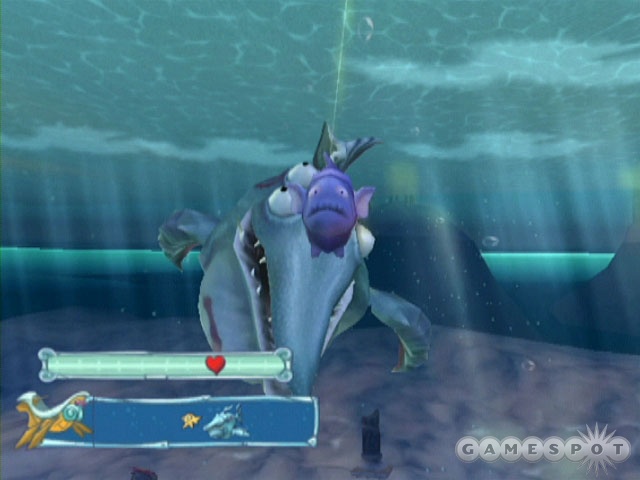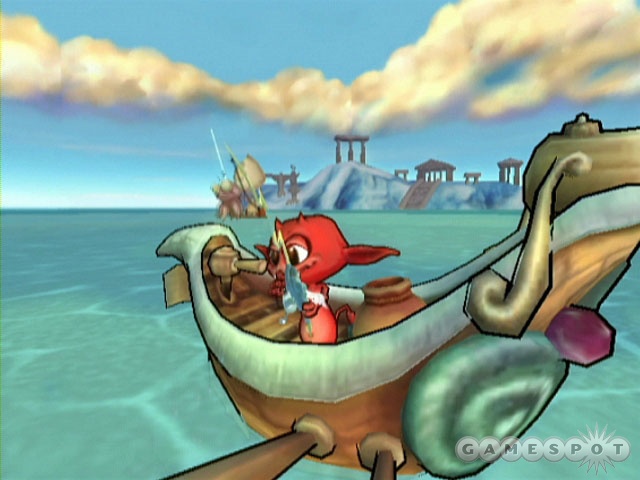Neko Entertainment's plucky little demon, Cocoto, is an unfortunate mascot. He's certainly just as cute as any of the better-known, multigenre mascots out there, and the world he lives in is overflowing with story opportunities, but he just can't seem to catch a break. He's got potential, but game mascots needs something more than potential to succeed: they need a good game, something Cocoto Fishing Master isn't.
Your motivation for fishing in the game is to catch five special fish that will wake up a sleeping fish king who has the power to stop a magical kettle from exploding, or something like that. The story doesn't make much sense, nor is it presented well. The barely comprehensible text and blurry pictures you're given at the beginning of the game attempt to wrap fishing in an adventure, but they fall flat. Thankfully, a full understanding of the story isn't needed to partake in a little fishing action. An understanding of the controls, on the other hand, is.

Other than a quick blurb from your fishing fairy friend describing the basic controls, there are no tutorials or instructions to help you reel in the required fish. At first, while you fling and waggle the Wii Remote and Nunchuk to figure out how to play, you may think the controls are sluggish or unresponsive, when the exact opposite is the case. Every action in Cocoto Fishing Master requires absolute precision. There's no margin of error here--you're either holding the remote correctly or you're not. You'll watch a lot of fish slip away thanks to the finicky controls.
Each level tasks you with retrieving six different fish so that a crazy-looking sea turtle can use them to make you special bait to catch a boss fish. Surplus fish can be sold in order to buy new rods and bait.
Finding fish is as easy as looking on your radar and casting in their direction. Each level of water has two types of fish and they’re color-coded on your radar, so you won't spend too much time searching for what you need. You can use surface, shallow, or deep bait to catch fish in the corresponding section. In every stage lurks a fish that will eat your reusable bait if it gets too close, but since it shows up on your radar as a red dot, it's not hard to avoid. Shaking and twisting your bait isn't necessary to attract fish; as long as you cast in the general area of a fish, you'll have a bite within seconds.
When a fish is interested you'll launch into a minigame that requires you to use the analog stick to keep the bait in front of its face long enough to get it to bite. This is one of the more entertaining parts of the game. Some of the fish in the later levels have complex patterns and clever juke moves that will keep you on your toes. After the minigame, you'll have to set the hook, which is easier said than done. The rigid controls require a specific upward motion. Tilt the remote up too early and it won't set; too late and the fish will spit it out.
If you can get the fish snared, you'll use the Nunchuk to reel it in. Once again, the controls only recognize precise movements, so you'll need to make nearly perfect circles for uninterrupted reeling; anything else will result in a staggered, slow pull. While there are some tough fish out there, reeling in a big catch is rewarding only because it means you made it through the casting and catching process without the controls failing you, not because of the struggle of the fish. With a steady hand and a good deal of patience, you won't break too many lines due to tension.
Above the water, the visuals don't look so hot. The endless ocean looks more like a billowing bedsheet than rolling water, and the backdrops and layouts for each of the five levels really only differ in color. Below the surface, things look a little nicer, despite a bit of pop-in and texture tearing. Fish swim about, plants sway, light filters through the surface, and the water is filled with specs and bubbles.

Cocoto and his fellow demons are cel-shaded, while the fish and environments all have a bright, wacky cartoon look. There are only six types of fish in the game, but each level offers different variations of them. The fish animate nicely with a broad range of movement and emotions. Watching your bait, be it a nervous seahorse or a paranoid squid, anxiously wiggle on the line as its eyes dart around in fearful anticipation of the next bite is always entertaining. The sound consists mostly of underwater gurgling noises and calming massage parlor music. The sounds that come from Cocoto are repetitive, and depending on how often you fail due to the controls, might drive you insane.
Given that Cocoto Fishing Master was originally released as a full game for the PS2 (complete with fishing controller), at 700 Wii points on WiiWare it might seem like a bargain. But when you consider the repetitiveness, control issues, and the fact that you can see all the game has to offer in five hours, the value of this purchase still comes into question. Cocoto Fishing Master is certainly no catch of the day, but it's not so bad that you'll want to throw it back into the water either. Consider this game's potential the one that got away.